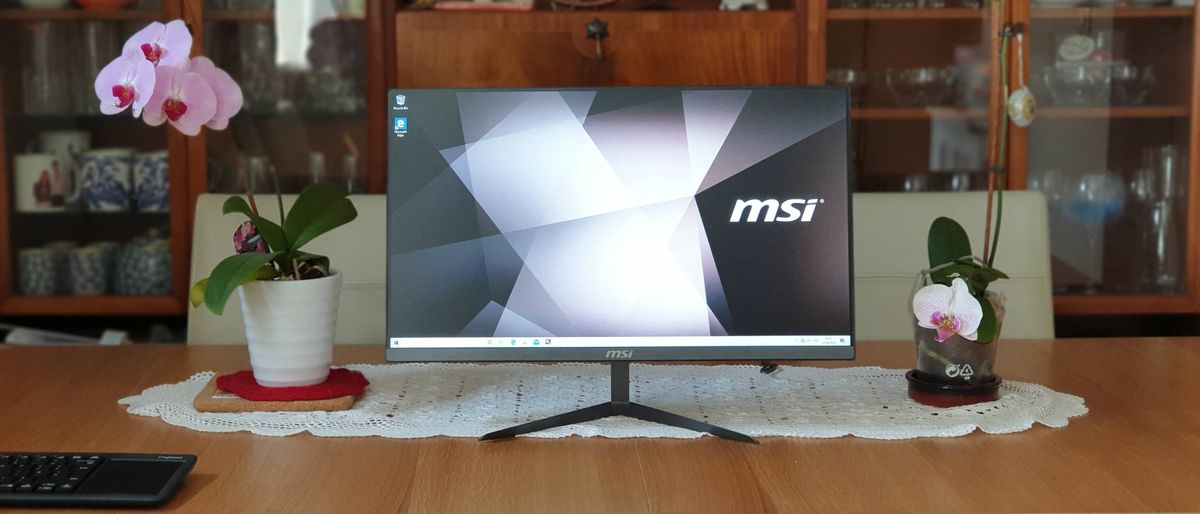TechRadar Verdict
MSI needs to go back to the drawing board and work the Pro 24X 10M into a proper iMac competitor. It is more expensive than the competition and the fundamentals are there but there’s simply too many niggling issues.
Pros
- +
Plenty of connection capabilities
- +
Dual GbE connectors
Cons
- -
Rather expensive
- -
Average value for money
- -
Lower bezel design
- -
No height control
- -
Basic tilt
- -
Bloatware
- -
No OSD control for monitor
- -
No card reader
- -
No webcam
- -
No Type-C connector
- -
USB 2.0 ports
- -
Quite noisy
- -
No keyboard and mouse
Why you can trust TechRadar
The MSI Pro 24X which we are reviewing today is an all-in-one (AIO) personal computer “optimized for professional use” says the marketing blurb. What that means in practice we shall discover a bit later; the model under scrutiny exists as eight variants with the differences being the CPU used, the amount of memory and the storage subsystem. We’re testing the 10M042EU which is equivalent to the 10M060US.
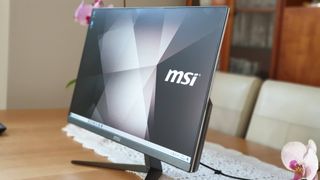
Design
What strikes you when you pull out the Pro 24X 10M is how light it is; bearing in mind this is a 24-inch AIO. At only 9.79lbs (less than 4.5Kg), it is positively lightweight - although that excludes the weight of the power brick. Its dimensions - 21.2 x 6.69 x 15.75-inch - mean that it still occupies a non-negligible real estate and necessitates a decent sized stand; MSI engineers opted for one with a V-shaped foot that can be easily screwed on. You can also remove it altogether to fix the Pro 24X 10M on the wall thanks to a VESA mount.
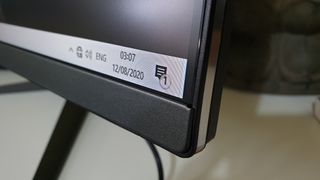
The front is dominated entirely by the gorgeous display with super thin bezel on three sides and a sizable lip on the bottom one. While I don’t mind the thickness, I do mind the fact that it is not flush with the glass panel as it will inevitably get clogged with dirt and dust particles over time. Apple got it right on that one. Oh and there’s no webcam which will be a deal breaker for some.
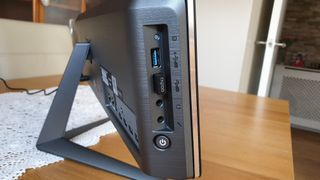
The rear contains storage for a spare 2.5-inch SATA bay for an extra SSD/HDD, hidden behind a flap. The components are also located in the same bulge towards the bottom of the monitor frame. Doing so gives it some stability (lower center of gravity) and plenty of vents means that hot air can be pushed out via fans and convection.
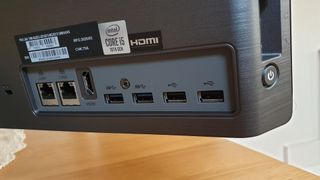
There’s also a Kensington lock, two Gigabit Ethernet ports, a HDMI out and four USB ports, two of which are … USB 2.0. On the left side of the AIO are two more USB ports, the power button, two audio connectors and what looks like a reset button.
Missing are the onscreen display controls (basically how to change the brightness and a flurry of other screen controls), a memory card reader and a Type-C connector which can be useful.
Hardware
Inside the MSI Pro 24X 10M is an Intel Core i5-10210U processor, 8GB memory in a single slot and a WD SN520 512GB NVMe M.2 SSD.
Here are the full specs of the MSI Pro 24X 10M configuration sent to TechRadar Pro for review:
CPU: Intel Core i5-10210U
Graphics: Intel UHD Graphics
RAM: 8GB
Screen: 23.8-inch IPS FHD resolution
Storage: WDC SN520 512GB
Ports: 4 x USB 3.1, 2 x USB 2.0, audio jack, 1 x HDMI, 2 x Gigabit Ethernet
Connectivity: Intel Wireless-AC 9462, 802.11ac Wi-Fi, Bluetooth 5.1
Weight: 4.44kg
Size: 538.44 x 169.96 x 399.96mm (H x W x D)
This quad-core CPU is still manufactured on a 14nm process but dissipates only 15W of power. It is reasonably powerful, probably the most capable low-power Core i5 on the market.
The rest of the configuration includes the 23.8-inch IPS full HD matte, non-touch display and a 178 degrees viewing angle, Intel’s Wireless-AC 9462 combo which supports Bluetooth 5.1, two 2.5W speakers and the power adaptor which is a classic brick-shaped one that provides 90W power.
Note that the AIO is not user-upgradable. There were no visible screws to remove to access the components inside.
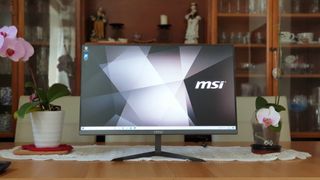
In use and performance
The fan is rather noisy under load with a noticeable whine, so much so for the “server-grade” heatsink. The build quality was good without being exceptional. It felt a bit plasticky and the small tiny gaps between the glass panel and the surrounding frame might put some users off.
Here’s how the MSI Pro 24X 10M performed in our suite of benchmark tests:
Passmark: 3560
Passmark CPU: 8026
CPU-Z: 474 (single-thread); 2316 (multi-thread)
Geekbench: 1080 (single-core); 3072 (multi-core); 4946 (compute)
CrystalDiskMark: 1656.7MBps (read); 1460.1MBps (write)
Cinebench CPU: 1167
Novabench: 1496
Atto: 1580MBps (read, 256mb); 1360MBps (write, 256mb)
AJA: 1490MBps (read); 1338MBps (write)
Windows Experience Index: 5.8
We didn’t get any keyboard and mouse although the description page did mention the accessories. There’s also a significant amount of bloatware; the ubiquitous Microsoft 365 (known as Office 365), 60-day trial to Norton Security plus an assortment of Cyberlink multimedia products (e.g. PhotoDirector).
MSI has a utility called Scenamax which replaces the traditional OSD controls; sadly it is tucked away behind an icon. Our last concern is that you can’t adjust the height of the device. You can tilt it slightly to and fro but that’s about it.
As for benchmarks, the combination of a relatively powerful CPU and a fast storage subsystem delivered some good scores (but not great). The WD SSD is no match for a Samsung 970 SSD like the Evo Plus and the 10210U is a laptop CPU which means that there’s some compromise with regards to clock speeds. Still, office-based workloads will be easily dealt with by the MSI Pro 24X 10M.
The competition
The MSI Pro 24X 10M comes with a one-year warranty and doesn’t have the ability to offer like the top three vendors the option for a next business day, onsite warranty. As a reminder, the Core i5 version retails for $900 with 8GB RAM, a 512GB SSD and Windows 10 Home.
Dell sells the Inspiron 24 5000 which has the same CPU, the same amount of memory but half the storage. On the other hand, it has a touchscreen display and a webcam and costs a bit more than MSI’s candidate at $949. You also get 1-Year ProSupport with Next Business Day Onsite Service.
HP has the Pavilion 24-K0225m which is powered by an AMD Ryzen 3 CPU. The rest of the specification is largely similar to the MSI AIO but it does have a webcam, a bigger power supply unit and a white wireless keyboard and mouse combo. Pricewise, there’s no competition. HP’s model comes in at $680.
We’ve kept the best for last; the Lenovo IdeaCentre AIO 3 costs $780, still about $120 cheaper than its MSI counterpart but comes with an AMD Ryzen 5 4500U with six cores and a faster AMD Radeon graphics. It does also have a webcam with a privacy shutter and a rather peculiar stand that will divide opinions. Oh and there’s even a DVD writer.
Final verdict
Perhaps the biggest issue with the Pro 24X 10M is the fact that it is more expensive than the competition, especially when compared to AMD-based all-in-one PC. Once you go past that point, the MSI Pro 24X 10M is not far from excellence but rarely has the idiom “so close, yet so far” rung true. The cons, which are minor but numerous, should be easy to solve in order to make this product, a decent alternative to the Apple iMac.
As a reminder they are, lack of OSD control for the monitor, absence of card reader, webcam or Type-C connector (for faster storage transfer). It is also quite noisy, its height can’t be adjusted, the speakers are meh, it lacks a dual microphone setup and there’s a fair bit of bloatware.
Oh and for good measure, we’d love to see the good ol’ power brick go away and replaced by one of these much smaller GaN power adaptors that can deliver 100W.
- Also check out our complete list of the best all-in-one computers

Désiré has been musing and writing about technology during a career spanning four decades. He dabbled in website builders and web hosting when DHTML and frames were in vogue and started narrating about the impact of technology on society just before the start of the Y2K hysteria at the turn of the last millennium.
Most Popular



